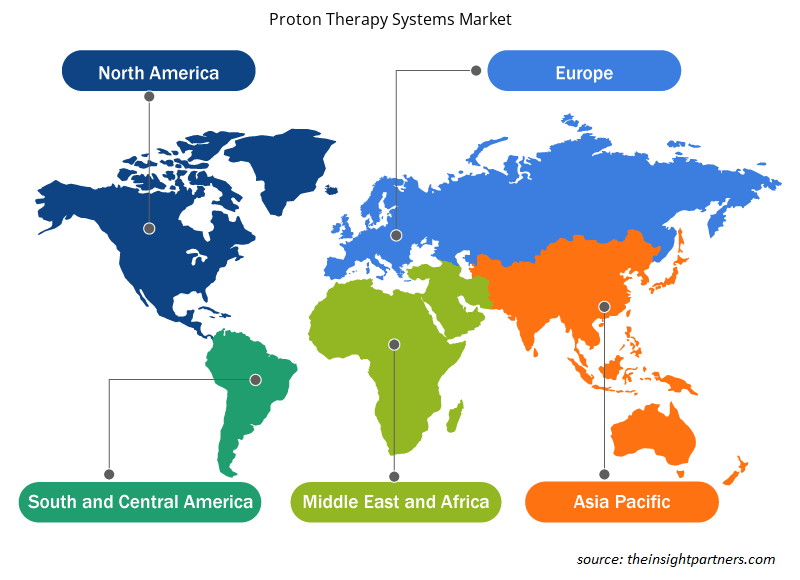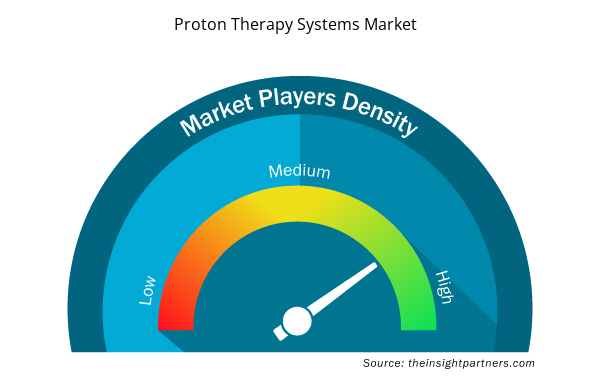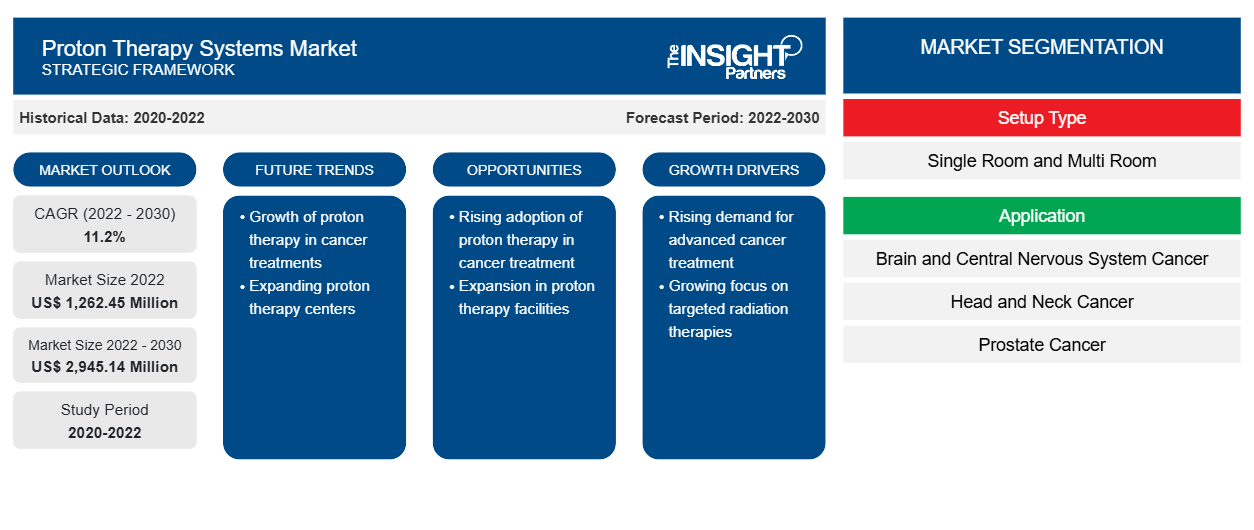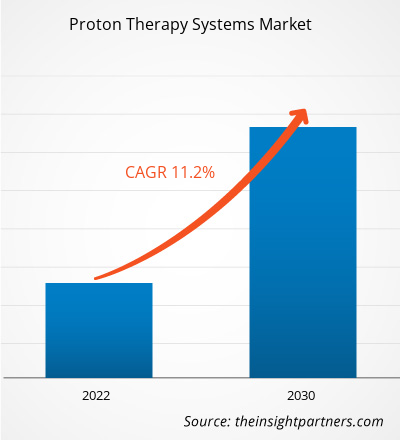[Rapporto di ricerca] Si prevede che il mercato dei sistemi di terapia protonica crescerà da 1.262,45 milioni di dollari nel 2022 a 2.945,14 milioni di dollari entro il 2030; si stima che registrerà un CAGR dell'11,2% nel periodo 2022-2030.
Approfondimenti di mercato e opinioni degli analisti:
Le previsioni di mercato dei sistemi di terapia protonica possono aiutare gli stakeholder di questo mercato a delineare le loro strategie di crescita.
Un sistema di terapia protonica è un dispositivo medico avanzato impiegato per fornire un trattamento radioterapico altamente preciso per i tumori. Questi sistemi sono di grandi dimensioni e sono costituiti da un acceleratore (ciclotrone), un sistema di trasporto del fascio, un sistema di selezione dell'energia e un'apparecchiatura di irradiazione a portale rotante. Grazie alla sua efficacia nel trattamento di alcuni tipi di cancro, c'è stata una crescente domanda di terapia protonica in tutto il mondo. Fattori come la crescente domanda di trattamenti avanzati con l'aumento dell'incidenza del cancro e il crescente sostegno governativo ai centri di terapia protonica spingono la crescita del mercato dei sistemi di terapia protonica. Tuttavia, l'elevato costo e l'ampia area dei sistemi di terapia protonica ostacolano la crescita del mercato. Inoltre, si prevede che la crescente adozione di approcci di trattamento personalizzati con progressi tecnologici porterà nuove tendenze di mercato dei sistemi di terapia protonica nei prossimi anni.
Fattori di crescita:
La crescente domanda di trattamenti avanzati con l'aumento dell'incidenza del cancro stimola la crescita del mercato
Secondo l'Agenzia Internazionale per la Ricerca sul Cancro (IARC), i tipi di cancro al polmone, al seno e alla prostata hanno avuto il tasso di incidenza più alto nel 2022. Queste malattie hanno un tasso standardizzato per età di 23,6, 47,1 e 29,4 casi ogni 100.000 abitanti, rispettivamente. Secondo le stime dell'IARC, si prevede che il numero totale di casi di cancro passerà da 19,98 milioni nel 2022 a 23,71 milioni entro il 2030 e 30,97 milioni entro il 2045. Varie condizioni tumorali, come i tumori della testa e del collo (nasale, orale, oculare e della laringe) e i tumori cerebrali, hanno requisiti di trattamento precisi, il che si traduce in un'elevata domanda di approcci di trattamento avanzati come la terapia protonica a intensità modulata (IMPT). Nelle tradizionali radioterapie, come la radioterapia a raggi X , anche il tessuto sano attorno al tumore riceve una dose di radiazioni, che porta a effetti collaterali e può causare tumori secondari. Tuttavia, la terapia protonica aiuta nel trattamento efficace di tumori complicati nel cervello e nella regione della testa e del collo, riducendo al minimo i danni collaterali ai tessuti circostanti. Pertanto, l'elevata prevalenza di cancro e la domanda di trattamenti avanzati aumentano la domanda di radioterapia basata sui protoni, alimentando la crescita del mercato dei sistemi di terapia protonica.
Personalizza questo report in base alle tue esigenze
Riceverai la personalizzazione gratuita di qualsiasi report, comprese parti di questo report, o analisi a livello nazionale, pacchetto dati Excel, oltre a usufruire di grandi offerte e sconti per start-up e università
- Scopri le principali tendenze di mercato in questo rapporto.Questo campione GRATUITO includerà analisi di dati che spaziano dalle tendenze di mercato alle stime e alle previsioni.
Contenimento:
Costi elevati e ampia area dei sistemi di terapia protonica
Un sistema di terapia protonica è un dispositivo medico avanzato utilizzato nel trattamento radioterapico ad alta precisione per i tumori. È un enorme dispositivo medico costituito da un acceleratore (ciclotrone), un sistema di trasporto del fascio, un sistema di selezione dell'energia e un'apparecchiatura di irradiazione a portale rotante, che si traduce in ampie superfici e costi elevati delle apparecchiature. Secondo l'Università della Pennsylvania (Oncolink), i ciclotroni dei sistemi di terapia protonica pesano fino a 200 tonnellate e hanno un diametro di 6-12 piedi. Il portale può pesare 100 tonnellate e avere un diametro di 40 piedi. Secondo uno studio pubblicato (2021) su IOPscience, anche il design compatto (configurazione a stanza singola) comporta un'area di 100 mq, mentre i sistemi di terapia protonica multi-stanza occupano 200-400 mq di area.
Inoltre, i sistemi di terapia protonica sono altamente dispendiosi in termini di capitale. Ad esempio, un sistema a stanza singola può costare circa 30-50 milioni di dollari. Il costo dei sistemi protonici multi-gantry può partire da 300 milioni di dollari in poi e di solito vengono installati solo in grandi ospedali e sistemi universitari. Pertanto, elevati requisiti di investimento di capitale e grandi aree di installazione sono tra i fattori che ostacolano la crescita del mercato dei sistemi di terapia protonica.
Segmentazione e ambito del report:
L'analisi di mercato dei sistemi di terapia protonica è stata condotta prendendo in considerazione i seguenti segmenti: tipo di configurazione e applicazione.
In base al tipo di configurazione, il mercato è diviso in single room e multi room. Il segmento multi room ha detenuto una quota di mercato maggiore nei sistemi di terapia protonica nel 2022. Inoltre, si prevede che il segmento single room registrerà un CAGR più rapido durante il periodo di previsione.
Il mercato, per applicazione, è categorizzato in cancro al cervello e al sistema nervoso centrale, cancro alla testa e al collo, cancro alla prostata, cancro al seno, cancro ai polmoni , cancro gastrointestinale e altri. Il segmento del cancro al cervello e al sistema nervoso centrale ha detenuto la quota di mercato più grande dei sistemi di terapia protonica nel 2022 e si prevede che registrerà il CAGR più elevato durante il periodo di previsione.
Analisi regionale:
In termini geografici, l'ambito del rapporto di mercato sui sistemi di terapia protonica include Nord America, Europa, Asia Pacifico, Sud e Centro America e Medio Oriente e Africa. Nel 2022, il Nord America ha rappresentato la quota di mercato maggiore.La crescente accettazione e adozione dei più recenti dispositivi medici, l'elevata prevalenza del cancro e le innovazioni di prodotto da parte dei principali attori contribuiscono all'espansione delle dimensioni del mercato dei sistemi di terapia protonica in Nord America. Secondo le stime dell'American Cancer Society, gli Stati Uniti hanno registrato circa 1,95 milioni di nuovi casi di cancro e circa 0,61 milioni di decessi correlati alla malattia nel 2023, con un aumento significativo rispetto a 1,60 milioni di casi di cancro e 0,60 milioni di decessi segnalati nel 2020. Secondo il Particle Therapy Co-Operative Group, alla fine del 2023, gli Stati Uniti avevano il numero più alto di sistemi di terapia protonica a livello globale, con 46 strutture di trattamento per terapia protonica.
Approfondimenti regionali sul mercato dei sistemi di terapia protonica
Le tendenze regionali e i fattori che influenzano il mercato dei sistemi di terapia protonica durante il periodo di previsione sono stati ampiamente spiegati dagli analisti di Insight Partners. Questa sezione discute anche i segmenti di mercato dei sistemi di terapia protonica e la geografia in Nord America, Europa, Asia Pacifico, Medio Oriente e Africa e America meridionale e centrale.

- Ottieni i dati specifici regionali per il mercato dei sistemi di terapia protonica
Ambito del rapporto di mercato sui sistemi di terapia protonica
| Attributo del report | Dettagli |
|---|---|
| Dimensioni del mercato nel 2022 | 1.262,45 milioni di dollari USA |
| Dimensioni del mercato entro il 2030 | 2.945,14 milioni di dollari USA |
| CAGR globale (2022-2030) | 11,2% |
| Dati storici | 2021-2022 |
| Periodo di previsione | 2022-2030 |
| Segmenti coperti | Per tipo di installazione
|
| Regioni e Paesi coperti | America del Nord
|
| Leader di mercato e profili aziendali chiave |
|
Densità degli attori del mercato dei sistemi di terapia protonica: comprendere il suo impatto sulle dinamiche aziendali
Il mercato dei sistemi di terapia protonica sta crescendo rapidamente, spinto dalla crescente domanda degli utenti finali dovuta a fattori quali l'evoluzione delle preferenze dei consumatori, i progressi tecnologici e una maggiore consapevolezza dei benefici del prodotto. Con l'aumento della domanda, le aziende stanno ampliando le loro offerte, innovando per soddisfare le esigenze dei consumatori e capitalizzando sulle tendenze emergenti, il che alimenta ulteriormente la crescita del mercato.
La densità degli operatori di mercato si riferisce alla distribuzione di aziende o società che operano in un particolare mercato o settore. Indica quanti concorrenti (operatori di mercato) sono presenti in un dato spazio di mercato in relazione alle sue dimensioni o al valore di mercato totale.
Le principali aziende che operano nel mercato dei sistemi di terapia protonica sono:
- Sistemi medici Varian Inc.
- Hitachi Ltd
- Sumitomo Heavy Industries Limited
- Applicazioni del fascio ionico SA
- Sistemi medici Mevion
Disclaimer : le aziende elencate sopra non sono classificate secondo un ordine particolare.

- Ottieni una panoramica dei principali attori del mercato dei sistemi di terapia protonica
Sviluppi del settore e opportunità future:
Di seguito sono elencati alcuni sviluppi strategici dei principali attori operanti nel mercato dei sistemi di terapia protonica, come riportato nei comunicati stampa aziendali:
- Nel gennaio 2024, OncoRay ha lanciato il prototipo di un sistema di terapia protonica guidata da MRI a corpo intero per il monitoraggio in tempo reale di tumori in movimento mediante risonanza magnetica per immagini (MRI) durante la terapia protonica. La MRI aiuta nella visualizzazione dei tumori con contrasto migliorato, che è il suo principale vantaggio rispetto alle modalità di imaging convenzionali. Un contrasto migliore consente di delineare meglio il tumore dal tessuto sano circostante e di definire il volume da irradiare con maggiore precisione.
- A dicembre 2023, HKSH Medical Group ha aperto un nuovo centro di terapia protonica presso l'HKSH Eastern Medical Centre di A Kung Ngam, Shau Kei Wan, Hong Kong. Il nuovo centro è dotato di un sistema avanzato di terapia protonica e due sale di trattamento all'avanguardia. Il sistema include due portali di terapia protonica semi-rotanti, il più recente sistema di trasporto del fascio e un acceleratore basato su sincrotrone.
Scenario competitivo e aziende chiave:
Varian Medical Systems Inc, Sumitomo Heavy Industries Ltd, Hitachi Ltd, Ion Beam Applications SA, Mevion Medical Systems, Provision Healthcare LLC, ProTom International, Optivus Proton Therapy Inc, Advanced Oncotherapy plc e B dot Medical Inc sono tra le aziende di spicco descritte nel report di mercato sui sistemi di terapia protonica. Queste aziende si concentrano sullo sviluppo di nuove tecnologie, sull'aggiornamento dei prodotti esistenti e sull'espansione della loro presenza geografica per soddisfare la crescente domanda dei consumatori in tutto il mondo.
- Analisi storica (2 anni), anno base, previsione (7 anni) con CAGR
- Analisi PEST e SWOT
- Valore/volume delle dimensioni del mercato - Globale, regionale, nazionale
- Industria e panorama competitivo
- Set di dati Excel



Report Coverage
Revenue forecast, Company Analysis, Industry landscape, Growth factors, and Trends

Segment Covered
This text is related
to segments covered.

Regional Scope
North America, Europe, Asia Pacific, Middle East & Africa, South & Central America

Country Scope
This text is related
to country scope.
Domande frequenti
A proton therapy system is an advanced medical device employed to provide a highly precise radiation treatment for tumors. These systems are huge in size, and they consist of an accelerator (cyclotron), beam transport system, energy selection system, and rotating gantry irradiation equipment. Due to its effectiveness in treating certain types of cancer, there has been a growing demand for proton therapy worldwide.
Factors such as rising demand for advanced treatments with the surging cancer incidence, and increasing government support for proton therapy centers propel the proton therapy systems market growth. However, the high cost and large area of proton therapy systems hamper the growth of the market.
The proton therapy systems market is expected to be valued at US$ 2,945.14 million in 2030.
The proton therapy systems market majorly consists of the players, including Varian Medical Systems Inc, Sumitomo Heavy Industries Ltd, Hitachi Ltd, Ion Beam Applications SA, Mevion Medical Systems, Provision Healthcare LLC, ProTom International, Optivus Proton Therapy Inc, Advanced Oncotherapy plc, and B dot Medical Inc
By setup type, the market is bifurcated into single room and multi room. The multi room segment held a larger proton therapy systems market share in 2022. Further, the single room segment is anticipated to register a faster CAGR during the forecast period.
The proton therapy systems market was valued at US$ 1,262.45 million in 2022.
The market, by application, is categorized into brain and central nervous system cancer, head and neck cancer, prostate cancer, breast cancer, lung cancer, gastrointestinal cancer, and others. The brain and central nervous system cancer segment held the largest proton therapy systems market share in 2022, and it is anticipated to register the highest CAGR during the forecast period.
Trends and growth analysis reports related to Life Sciences : READ MORE..
The List of Companies - Proton Therapy Systems Market
- Varian Medical Systems Inc
- Hitachi Ltd
- Sumitomo Heavy Industries Limited
- Ion Beam Applications SA
- Mevion Medical Systems
- Provision Healthcare LLC
- ProTom International
- Optivus Proton Therapy Inc
- Advanced Oncotherapy plc
- B dot Medical Inc
The Insight Partners performs research in 4 major stages: Data Collection & Secondary Research, Primary Research, Data Analysis and Data Triangulation & Final Review.
- Data Collection and Secondary Research:
As a market research and consulting firm operating from a decade, we have published and advised several client across the globe. First step for any study will start with an assessment of currently available data and insights from existing reports. Further, historical and current market information is collected from Investor Presentations, Annual Reports, SEC Filings, etc., and other information related to company’s performance and market positioning are gathered from Paid Databases (Factiva, Hoovers, and Reuters) and various other publications available in public domain.
Several associations trade associates, technical forums, institutes, societies and organization are accessed to gain technical as well as market related insights through their publications such as research papers, blogs and press releases related to the studies are referred to get cues about the market. Further, white papers, journals, magazines, and other news articles published in last 3 years are scrutinized and analyzed to understand the current market trends.
- Primary Research:
The primarily interview analysis comprise of data obtained from industry participants interview and answers to survey questions gathered by in-house primary team.
For primary research, interviews are conducted with industry experts/CEOs/Marketing Managers/VPs/Subject Matter Experts from both demand and supply side to get a 360-degree view of the market. The primary team conducts several interviews based on the complexity of the markets to understand the various market trends and dynamics which makes research more credible and precise.
A typical research interview fulfils the following functions:
- Provides first-hand information on the market size, market trends, growth trends, competitive landscape, and outlook
- Validates and strengthens in-house secondary research findings
- Develops the analysis team’s expertise and market understanding
Primary research involves email interactions and telephone interviews for each market, category, segment, and sub-segment across geographies. The participants who typically take part in such a process include, but are not limited to:
- Industry participants: VPs, business development managers, market intelligence managers and national sales managers
- Outside experts: Valuation experts, research analysts and key opinion leaders specializing in the electronics and semiconductor industry.
Below is the breakup of our primary respondents by company, designation, and region:

Once we receive the confirmation from primary research sources or primary respondents, we finalize the base year market estimation and forecast the data as per the macroeconomic and microeconomic factors assessed during data collection.
- Data Analysis:
Once data is validated through both secondary as well as primary respondents, we finalize the market estimations by hypothesis formulation and factor analysis at regional and country level.
- Macro-Economic Factor Analysis:
We analyse macroeconomic indicators such the gross domestic product (GDP), increase in the demand for goods and services across industries, technological advancement, regional economic growth, governmental policies, the influence of COVID-19, PEST analysis, and other aspects. This analysis aids in setting benchmarks for various nations/regions and approximating market splits. Additionally, the general trend of the aforementioned components aid in determining the market's development possibilities.
- Country Level Data:
Various factors that are especially aligned to the country are taken into account to determine the market size for a certain area and country, including the presence of vendors, such as headquarters and offices, the country's GDP, demand patterns, and industry growth. To comprehend the market dynamics for the nation, a number of growth variables, inhibitors, application areas, and current market trends are researched. The aforementioned elements aid in determining the country's overall market's growth potential.
- Company Profile:
The “Table of Contents” is formulated by listing and analyzing more than 25 - 30 companies operating in the market ecosystem across geographies. However, we profile only 10 companies as a standard practice in our syndicate reports. These 10 companies comprise leading, emerging, and regional players. Nonetheless, our analysis is not restricted to the 10 listed companies, we also analyze other companies present in the market to develop a holistic view and understand the prevailing trends. The “Company Profiles” section in the report covers key facts, business description, products & services, financial information, SWOT analysis, and key developments. The financial information presented is extracted from the annual reports and official documents of the publicly listed companies. Upon collecting the information for the sections of respective companies, we verify them via various primary sources and then compile the data in respective company profiles. The company level information helps us in deriving the base number as well as in forecasting the market size.
- Developing Base Number:
Aggregation of sales statistics (2020-2022) and macro-economic factor, and other secondary and primary research insights are utilized to arrive at base number and related market shares for 2022. The data gaps are identified in this step and relevant market data is analyzed, collected from paid primary interviews or databases. On finalizing the base year market size, forecasts are developed on the basis of macro-economic, industry and market growth factors and company level analysis.
- Data Triangulation and Final Review:
The market findings and base year market size calculations are validated from supply as well as demand side. Demand side validations are based on macro-economic factor analysis and benchmarks for respective regions and countries. In case of supply side validations, revenues of major companies are estimated (in case not available) based on industry benchmark, approximate number of employees, product portfolio, and primary interviews revenues are gathered. Further revenue from target product/service segment is assessed to avoid overshooting of market statistics. In case of heavy deviations between supply and demand side values, all thes steps are repeated to achieve synchronization.
We follow an iterative model, wherein we share our research findings with Subject Matter Experts (SME’s) and Key Opinion Leaders (KOLs) until consensus view of the market is not formulated – this model negates any drastic deviation in the opinions of experts. Only validated and universally acceptable research findings are quoted in our reports.
We have important check points that we use to validate our research findings – which we call – data triangulation, where we validate the information, we generate from secondary sources with primary interviews and then we re-validate with our internal data bases and Subject matter experts. This comprehensive model enables us to deliver high quality, reliable data in shortest possible time.


 Ottieni un campione gratuito per questo repot
Ottieni un campione gratuito per questo repot